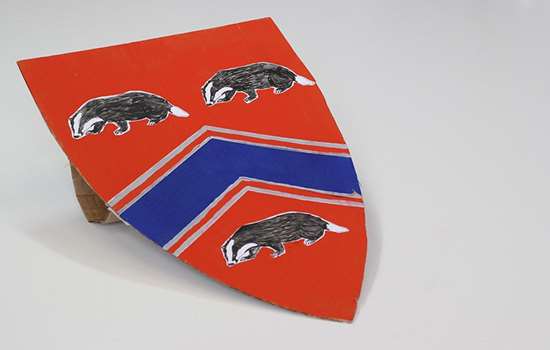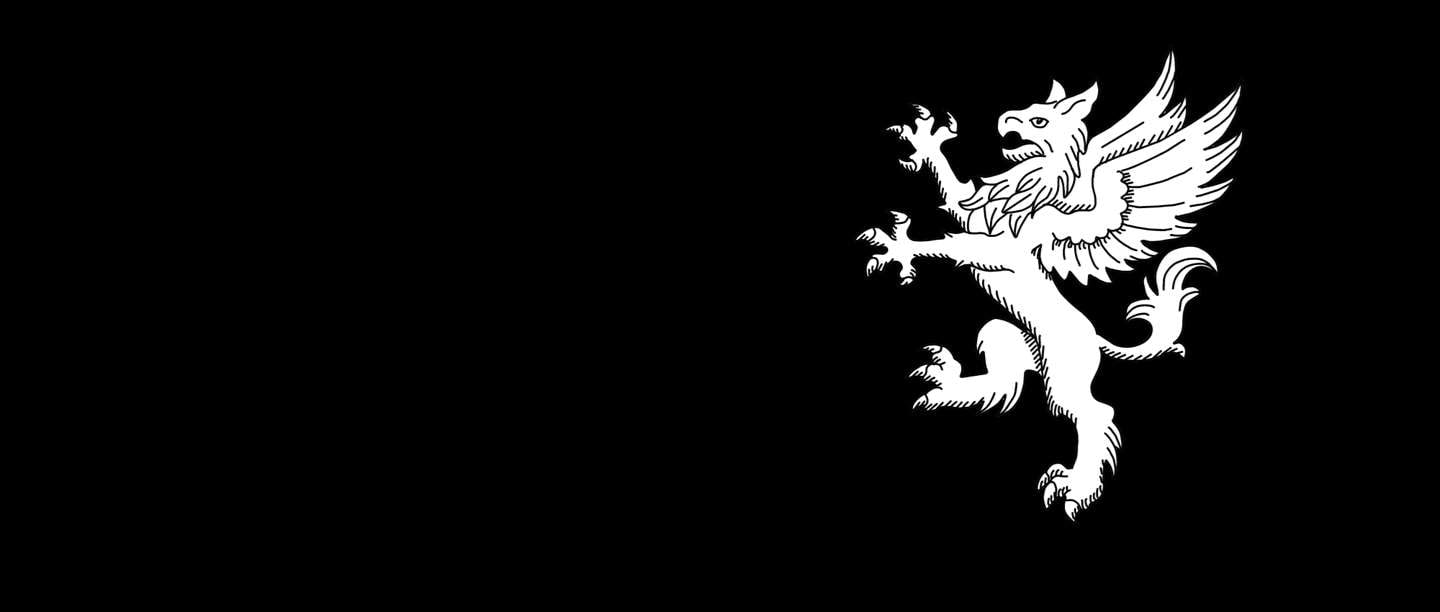How heraldry started
Heraldry is about showing people who you are. In England it started in the later 1100s, when knights began to wear helmets which covered their faces, and they couldn't be recognised. So they began to paint unique combinations of colours, shapes and animals, called their 'arms', on their shields and banners. Only one person was allowed to use these arms, so when people saw a knight wearing them in a battle or tournament, they could tell who he was.
Heraldic Code
When heraldry began, knights and their families spoke Norman French. Expert 'heralds' still use this language to describe coats of arms. You don't have to know this 'code' for your shield, but it's a very precise way of describing coats of arms, and it can be fun. In this guide the heraldic names for things are written in italics, like this.
The Colours of Heraldry
If you are making your own heraldry, use bright, strong colours. The five traditional colours are, with their heraldic names:
- Red = Gules
- Blue = Azure
- Green = Vert
- Black = Sable
- Purple = Purpure
Plus the two 'metals'
- Gold or yellow = Or
- Silver or white = Argent
There are also 'furs', the most common being:
- Ermine: representing the white winter fur of stoats, with their black tail tips.
- Vair: representing squirrel skins, in blue and white.
If something (say a dog or badger) is shown in its natural colours, it's called proper.
Heraldic Ordinaries
Ordinaries are the simple shapes used on heraldic shields, against a colour, metal or fur background. If you are making your own design, choose one of these main ordinaries:
- Fess = horizontal stripe across the shield
- Pale = vertical stripe down the shield
- Bend = diagonal stripe
- Chevron = like a house gable, pointing upwards
- Cross = a plain cross
- Saltire = a 'St. Andrew's cross'
- Chief = bar across top edge of shield
- Bordure = border round edges of shield
- Pile = downward-pointing triangle
You can also divide your shield into two colours, either vertically or horizontally, or into four different-coloured quarters.
You don't have to use an ordinary, but if you do remember to never put a colour on colour or a metal on a metal. Try to remember this heraldic rule: colours don't show up well against colours, or metals against metals. This also applies to charges.
Heraldic Charges
Charges are emblems added to the shield, on the background, the 'ordinary', or both. There can be one big charge, or several smaller repeated ones. Here are some of the common charges you could use:
- Crosses - of many different types
- Stars
- Rings
- Balls
- Crescents
- Diamonds
- Flowers
They can be any colour, but remember never put colour on colour, for example a green star on blue, or metal on metal, for example a white flower on yellow.
Many knights also used animals as charges.
Animal Charges
Any animal - either one big one or several smaller - can be used as a charge. They can be shown in many different ways, for instance:
- Rearing up (rampant) - like the lion and the hare in the pictures
- Standing (statant) - like the dog
- For birds, with wings outstretched (displayed) - like the eagle
- Walking along (passant) - like the other lion
If the animal is looking towards you, it is also guardant or 'on guard'. So the lion in the picture is passant guardant. The ancient royal arms of England are three golden lions, one above the other, walking along on a red shield: or in heraldic code gules three lions passant guardant or. (Just to make things more complicated, lions passant guardant are also called leopards - but they don't have spots!)
Choosing Your Animal
Animals symbolised different qualities. So for instance:
- Lions = bravery
- Dogs = faithfulness, reliability
- Stags = wisdom and long life
- Eagles = power and nobility
- Hares= speed
- Badgers = endurance or 'hanging on'
You could also design your own animal charge--for instance a cat, horse or other favourite pet. Or you could choose a fabulous beast.
Heraldry Activity Pack
If you'd like to use one of our fabulous beasts or animal charges to make your own heraldry design or coat of arms, download our activity and choose your favourite one to cut out and colour in.
Download PDFFabulous Beasts
Though often used as 'charges', these fabulous beasts never really existed. But some people believed they did, maybe because they'd heard about them in stories made up by travellers to distant lands, like crusading knights or merchant adventurers. Pictures of them also appeared in 'bestiaries', a popular kind of illustrated medieval story-book.
Here are some you could use:
- Dragon: the earliest and most common fabulous beast, also used as a badge by Romans, Anglo-Saxons and Welsh. A brave and cunning defender of treasure.
- Griffin: a combination of lion and eagle. Symbolises watchfulness and courage - and also guards treasure.
- Cockatrice: a cross between a cockerel and a dragon, supposedly hatched from a cock's egg [!] by a snake or toad. Could kill by looking at you, and symbolised protection.
- Manticore or 'man-tiger': a fearsome man-eating creature with a lion's body, man's face, tusks, horns and a deafening trumpet-like voice. (Are you really like one of these?)
DESIGN YOUR OWN HERALDRY
Now that you've got to grips with the basic rules of heraldry, why not make design your own coat of arms? You could even make your own shield to display your design.
Don't forget to share your masterpieces with us on Facebook and Twitter.
More to Discover
-

Make a Shield
Make and decorate a shield and have the best looking protection around.
-

Make a Sword
Take a look at our guide to making your own trusty sword out of cardboard.
-

1066: The Year of the Normans
Discover more about the year that shaped English history forever.
